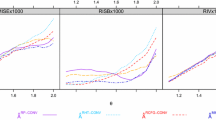Abstract
Quantifying dependence is a central theme in probabilistic and statistical methods for multivariate extreme values. Two situations are possible: one where, in a limiting sense, the extremes are dependent; the other where, in the same sense, the extremes are independent. This paper comprises an overview of the principal issues through a unified approach which encompasses both these situations. Novel diagnostic measures for dependence are also developed which provide complementary information about different aspects of extremal dependence. The paper is written in an elementary style, with the methodology illustrated by application to theoretical examples and typical data-sets. These data-sets and the S-plus functions used for the analyses are available online.
Similar content being viewed by others
References
Barão, M.I. and Tawn, J.A., “Extremal analysis of short series with outliers: sea-levels and athletics records,” Appl. Statist. 48, 469–487, (1999).
Bortot, P. and Tawn, J.A., “Models for the extremes of Markov chains,” Biometrika 85, 851–867, (1998).
Bortot, P., Coles, S.G., and Tawn, J.A., “The multivariate Gaussian tail model: an application to oceanographic data,” Appl. Statist., 49, 31–49 (2000).
Bruun, J.T. and Tawn, J.A., “Comparison of approaches for estimating the probability of coastal flooding,” Appl. Statist. 47, 405–423, (1998).
Capérá, P., Fougéres, A.-L., and Genest, C., “Estimation of bivariate extreme value copulas,” Biometrika 84, 567–577, (1997).
Coles, S.G., “A temporal study of extreme rainfall,” in Statistics for the Environment 2:Water Related Issues, (V. Barnett and K.F. Turkman, eds.), Wiley, Chichester, 61–78, (1994).
Coles, S.G. and Tawn, J.A., “Modelling extreme multivariate events,” J. R. Statist. Soc. B 53, 377–392, (1991).
Coles, S.G. and Tawn, J.A., “Statistical methods for multivariate extremes: an application to structural design (with discussion),” Appl. Statist. 43, 1–48, (1994).
Coles, S.G. and Tawn, J.A., “A Bayesian analysis of extreme rainfall data,” Appl. Statist. 45, 463–478, (1996).
Currie, J.E., “Directory of coefficients of tail dependence,” Department of Mathematics and Statistics Technical Report, ST-99-06, Lancaster University, 1999.
Davison, A.C. and Smith, R.L., “Models for exceedances over high thresholds (with discussion),” J. R. Statist. Soc. B 52, 393–442, (1990).
Dekkers, A.L.M., Einmahl, J.H.J., and de Haan, L., “A moment estimator for the index of an extreme value distribution,” Ann. Statist. 17, 1833–1855, (1989).
Einmahl, J.H.J., de Haan, L. and Sinha, A.K., “Estimating the spectral measure of an extreme value distribution,” Stoch. Proc. Appl. 70, 143–171, (1997).
Geffroy, J., “Contributions ála théorie des valeurs extrème,” Publ. Inst. Statist. Univ. Paris 7/8, 37–185, (1958/59).
de Haan, L., “Extremes in higher dimensions: the model and some statistics.” In Proc. 45th Sess. Int. Statist. Inst., paper 26.3. International Statistical Institute, The Hague, 1985.
de Haan, L. and de Ronde, J., “Sea and wind: multivariate extremes at work,” Extremes 1, 7–45, (1998).
Joe, H., “Families of min-stable multivariate exponential and multivariate extreme value distributions,” Statist. Probab. Lett. 9, 75–81, (1990).
Joe, H., “Multivariate extreme-value distributions with applications to environmental data,” Canadian. J. Statist 22, 47–64, (1994).
Joe, H., Multivariate Models and Dependence Concepts, Chapman & Hall, London, 1997.
Joe, H., Smith, R.L., and Weissman, I., “Bivariate threshold methods for extremes,” J. R. Statist. Soc. B 54, 171–183, (1992).
Leadbetter, M.R., Lindgren, G., and Rootzén, H., Extremes and Related Properties of Random Sequences and Series, Springer Verlag, New York, 1983.
Ledford, A.W., “Extreme values of the bivariate normal distribution,” Submitted, 1999.
Ledford, A.W. and Tawn, J.A., “Statistics for near independence in multivariate extreme values,” Biometrika 83, 169–187, (1996).
Ledford, A.W. and Tawn, J.A., “Modelling dependence within joint tail regions,” J. R. Statist. Soc. B 59, 475–499, (1997).
Ledford, A.W. and Tawn, J.A., “Concomitant tail behavior for extremes,” Adv. Appl. Probab. 30, 197–215, (1998).
Ledford, A.W. and Tawn, J.A., “Diagnostics for dependence within time-series extremes,” Submitted to J. R. Statist. Soc. B (2000).
Mardia, K.V., “Asymptotic independence of bivariate extremes,” Calcutta Statist. Assoc. Bull. 13, 172–178, (1964).
Nandagopalan, S., “On the multivariate extremal index,” Jnl of Research, National Inst. of Standards and Technology 99, 543–550, (1994).
Nelsen, R.B., An Introduction to Copulas, Springer-Verlag, New York, 1998.
Peng, L., “Estimation of the coefficient of tail dependence in bivariate extremes,” Statist. Probab. Lett. 43, 399–409, (1999).
Pickands, J., “Multivariate extreme value distributions,” Bull. Int. Statist. Inst. 49, 859–878, (1981).
Resnick, S.I., Extreme Values, Point Processes and Regular Variation, Springer-Verlag, New York, 1987.
Sibuya, M., “Bivariate extreme statistics,” Ann. Inst. Statist. Math. 11, 195–210, (1960).
Shi, D., Smith, R.L., and Coles, S.G., “Joint versus marginal estimation for bivariate extremes,” Department of Statistics Technical Report, 2074, University of North Carolina at Chapel Hill, 1992.
Smith, R.L., “Extreme value theory,” In Handbook of Applicable Mathematics, (W. Ledermann, ed), 7, chapter 14, 437–472, Chichester, Wiley, 1990.
Smith, R.L., “Multivariate threshold methods.” In Extreme Value Theory & Applications, (J. Galambos, J. Lechner and E. Simiu, eds) Kluwer, Dordrecht, 225–248, (1994).
Smith, R.L., Tawn, J.A., and Coles, S.G., “Markov chain models for thresholds exceedances,” Biometrika 84, 249–268, (1997).
Tawn, J.A., “Bivariate extreme value theory: models and estimation,” Biometrika 75, 397–415, (1988).
Tiago de Oliveira, J., “Structure theory of bivariate extremes, extensions,” Est. Mat., Estat. e. Econ. 7, 165–195, (1962/63).
Weintraub, K.S., “Sample and ergodic properties of some min-stable processes,” Annals Probab. 19, 706–723, (1991).
Yun, S., “The extremal index of a higher-order stationary Markov chain,” Ann. Appl. Probab. 8, 408–437, (1998).
Author information
Authors and Affiliations
Rights and permissions
About this article
Cite this article
Coles, S., Heffernan, J. & Tawn, J. Dependence Measures for Extreme Value Analyses. Extremes 2, 339–365 (1999). https://doi.org/10.1023/A:1009963131610
Issue Date:
DOI: https://doi.org/10.1023/A:1009963131610




